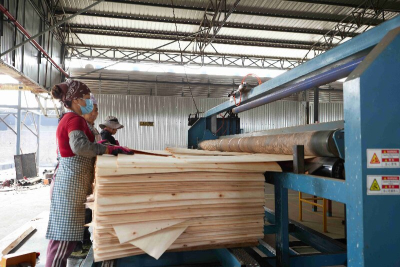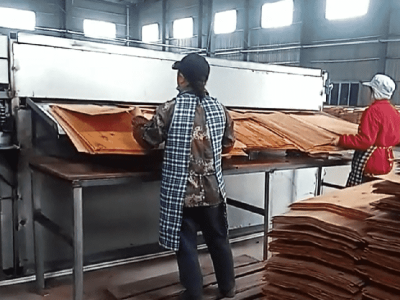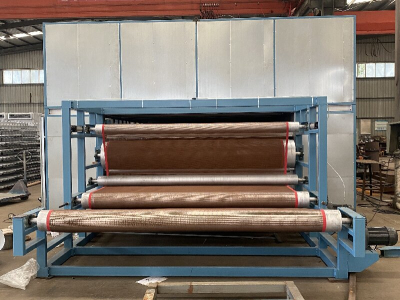Revolutionizing the Veneer Industry: Shine Wood's Automated Loading System Sets New Benchmark for Efficiency and Automation
In a significant leap forward for the global wood processing industry, Shine Wood, a premier manufacturer of wood processing machinery, has officially launched its groundbreaking Automated Panel Loading System for its flagship line of wood veneer dryers. This innovative system is not merely an incremental upgrade; it represents a fundamental re-engineering of the veneer drying workflow, delivering unprecedented gains in production efficiency, operational safety, and consistent product quality while dramatically reducing reliance on manual labor.
For decades, the process of loading delicate, freshly cut veneer sheets into dryers has been one of the most persistent bottlenecks in veneer production. This labor-intensive, physically demanding, and repetitive task has long been associated with high operational costs, variable product quality, and significant safety challenges. Shine Wood's engineering team has directly addressed these pain points with a solution that is as intelligent as it is robust.
1. The Core Challenge: The Traditional Veneer Loading Bottleneck
To fully appreciate the magnitude of Shine Wood's innovation, one must first understand the limitations of the traditional manual loading process.
High Labor Dependency and Cost: Manual loading requires a large crew working in shifts to feed sheets into the dryer. In an era of global labor shortages and rising wage costs, this has become a major financial and operational strain for veneer manufacturers.
Inconsistent Speed and Production Bottlenecks: Human workers have natural physical limits. The speed of the entire drying line is often dictated by the pace of the slowest loading team, creating a bottleneck that prevents high-capacity dryers from operating at their full potential. Production schedules are frequently disrupted by fatigue, breaks, and shift changes.
Variable Product Quality and Damage: Manual handling inevitably leads to variations in how sheets are placed. Misaligned, overlapping, or crumpled veneer sheets result in uneven drying, leading to spots that are too wet or too brittle. This directly causes a higher percentage of waste and lower-grade output. The delicate surfaces of premium woods like walnut wood veneer or beech wood veneer are particularly susceptible to scratches and tears from manual handling.
Significant Safety Risks: The interface between human workers and heavy, high-temperature industrial machinery is inherently hazardous. Repetitive strain injuries, hand entrapment, and exposure to heat are constant concerns, posing a threat to employee well-being and creating potential liability for manufacturers.
2. A Deep Dive into the Shine Automated Loading System: How It Works
Shine Wood's Automated Loading System is a marvel of integrated mechanical engineering, precision sensors, and sophisticated software control. It functions as a seamless, end-to-end solution that transforms a chaotic manual process into a smooth, automated material flow.
2.1. The Automated Unstacking and Singulation Module
The process begins at the infeed end, where stacks of green (undried) veneer are placed.
Vacuum Lifters: High-capacity, intelligent vacuum lifters, equipped with multiple suction cups, gently but firmly lift the top sheet from the stack. The vacuum pressure is automatically adjusted based on the sheet's thickness and wood species, whether it's a delicate customized wood veneer or a standard sheet, to prevent any damage.
Sheet Singulation: This is a critical step where many automated systems fail. Shine’s system uses a combination of precisely timed air blowers and mechanical separators to ensure that only one sheet is picked up at a time, eliminating the risk of double-feeding, which can jam the dryer.
2.2. The Intelligent Conveyance and Alignment System
Once singled out, the veneer sheet is transferred onto a high-precision conveyor system.
Laser Guidance and Vision Systems: An array of laser sensors and high-resolution cameras continuously scans the sheet's position and orientation on the conveyor.
Self-Correcting Mechanism: If a sheet is misaligned, a series of pneumatically actuated guide arms or driven rollers make micro-adjustments in real-time, perfectly squaring the sheet before it enters the dryer. This guarantees that every sheet of wood veneer enters the dryer in the optimal position for uniform air flow and heat transfer.
2.3. The High-Speed Accelerated Feed Mechanism
This is the component that directly addresses the production bottleneck.
Synchronized Belts: The system accelerates the perfectly aligned sheet to match the exact intake speed of the dryer. This eliminates the "stop-start" motion characteristic of manual feeding, creating a continuous, high-velocity stream of veneer entering the drying chamber.
Seamless Integration: The feed mechanism is fully synchronized with the dryer's own conveyor, ensuring a flawless handoff that prevents jams, gaps, or overlaps.
2.4. The Centralized Control and Human-Machine Interface (HMI)
The entire Automated Loading System is governed by a powerful Programmable Logic Controller (PLC).
User-Friendly HMI: Plant operators monitor and control the entire process from a vibrant touch-screen interface. The HMI displays real-time data on feeding rate, production count, system status, and any potential alerts.
Recipe Management: The system can store "recipes" for different products. With a few taps, an operator can switch from loading beech wood veneer to walnut wood veneer, with the system automatically adjusting vacuum pressure, feed speed, and alignment parameters for optimal results.
3. The Tangible Benefits: Quantifying the "Shine Advantage"
The implementation of this system delivers a rapid and substantial return on investment across multiple key performance indicators.
3.1. Dramatic Increase in Production Efficiency
Elimination of Bottlenecks: By maintaining a continuous, high-speed feed, the system allows the veneer dryer to operate at its maximum designed capacity, 24 hours a day, 7 days a week. Production line efficiency is reported to increase by 40-60%.
Increased Throughput: Manufacturers can process more cubic meters of wood veneer per shift, significantly boosting overall plant output and fulfilling larger orders faster.
3.2. Radical Reduction in Labor Costs and Dependency
Labor Reduction: The system reduces the number of workers required at the loading station from a team of 4-6 to a single supervisor/monitor. This translates to direct savings on wages, benefits, and training.
Solving Labor Shortages: It provides a strategic solution to the chronic challenge of finding and retaining workers for difficult and unattractive jobs, ensuring business continuity and scalability.
3.3. Unprecedented Consistency and Enhanced Product Quality
Perfect Alignment, Perfect Drying: By ensuring every sheet is perfectly positioned, the system guarantees uniform exposure to heat and airflow. This results in a consistently dried product with minimal moisture variation, reducing defects like cracking or warping.
Minimized Handling Damage: The "no-touch" or "low-touch" automation virtually eliminates the scratches, tears, and oil stains associated with manual handling. The quality of high-value customized wood veneer is preserved from start to finish.
Higher Yield and Profitability: A direct consequence of improved consistency and reduced damage is a higher yield of Grade-A veneer, directly boosting profitability for the veneer manufacturer.
3.4. Enhanced Workplace Safety and Morale
Removing Workers from Hazards: Automating the most dangerous part of the drying process drastically reduces the risk of workplace accidents.
Upskilling the Workforce: The remaining workforce can be upskilled to more rewarding roles, such as machine operation, quality control, and maintenance, leading to higher job satisfaction and lower turnover.
3.5. Improved Data and Process Traceability
The PLC system continuously logs production data, including the number of sheets processed, running time, and any stoppages. This data is invaluable for production planning, maintenance scheduling, and analyzing overall equipment effectiveness (OEE).
4. A Competitive Edge for the Modern Veneer Manufacturer
In an increasingly competitive global market, adopting such advanced technology is no longer a luxury but a necessity for forward-thinking companies. A veneer manufacturer equipped with Shine's Automated Loading System gains a decisive competitive edge:
They can offer more competitive pricing due to lower operational costs.
They can guarantee faster lead times and larger volumes, attracting major clients.
They can produce superior, more consistent quality, becoming a preferred supplier for high-end furniture makers and architectural projects that specify materials like walnut wood veneer and beech wood veneer.
5. The Future is Automated
The launch of the Automated Panel Loading System by Shine Wood marks a pivotal moment for the industry. It proves that the vision of a fully automated, "lights-out" veneer production plant is within reach. This system is more than just a piece of machinery; it is a strategic tool that empowers manufacturers to build a more resilient, profitable, and sustainable business.
"With this system, we are not just selling a machine; we are selling our partners a pathway to the future of wood processing," said a senior engineer at Shine Wood. "We are empowering them to produce more with less, to safeguard their workers, and to deliver a level of quality that was previously very difficult to achieve consistently. For the modern veneer manufacturer, automation is the key to growth and longevity."
As the industry continues to evolve, Shine Wood has positioned itself not just as an equipment supplier but as an innovation partner, leading the charge into a new era of intelligent, efficient, and safe veneer manufacturing.







